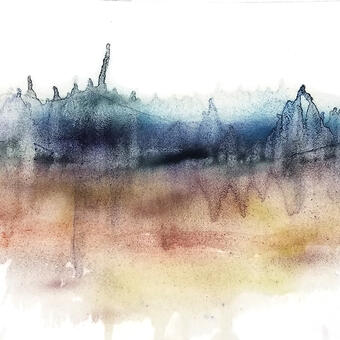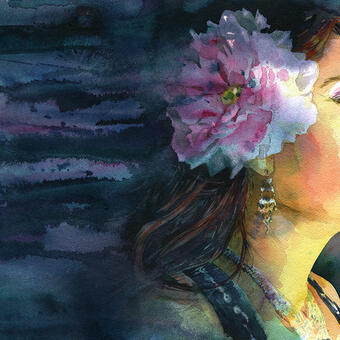About Charlotte
Howard County
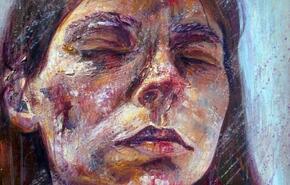
Charlotte Mann Lee was born in Columbia, MD in 1996. She is currently an artist at Long Reach Studios and was the 2019-2020 Emerging Artist Resident at the Howard County Center for the Arts in Ellicott City, MD. She has exhibited in various shows such as Persona (July 2019), HoCo Open 2020 (January 2020), LAG Open (March 2020) and HCCA’s Resident Visual Artist Exhibit (July 2020). In July 2019, she received the Carol Zink Open Paint Award after participating in the Paint It! Ellicott… more
Jump to a project:
Art Honors Thesis: A Would-be Perfectionist’s Pursuit of Joy through Faith and Painting
From my Art Honors Thesis(Spring 2018):
Being a quiet, introverted person, I often feel an imaginary barrier between myself and other people. While I desire to connect with others and share a piece of myself with them, this simple human need often goes unfulfilled. Perhaps this explains my need for creative expression through art. In this expressive act, painting is an outpouring of my soul. As the brush flicks in my hand and paint oozes out onto the canvas, so I pour myself out as an offering of thanks to God, praising Him for the gifts He has given me. Where I have difficulty connecting with others, painting gives me an avenue to express myself and share who I am in the truest, most authentic way I know. My work is an introvert’s look into self. I can share with others what’s inside, and by addressing personal experiences, I can open a forum for others to be honest about their own experiences, whether similar or different. I want to show not only what is on the surface, but also what is beneath, what is unseen, and perhaps let the viewer contemplate this side of themselves. Hence, I use a somewhat abstract, reactionary process in terms of color, texture, and stroke to communicate feeling and emotion in my work. Self-portraiture and abstract painting processes allow me to express and communicate these truths, to share my personal testimony of the spiritual realities of my life in Christ amidst varied emotions, and the highs and lows of daily life.
Being a quiet, introverted person, I often feel an imaginary barrier between myself and other people. While I desire to connect with others and share a piece of myself with them, this simple human need often goes unfulfilled. Perhaps this explains my need for creative expression through art. In this expressive act, painting is an outpouring of my soul. As the brush flicks in my hand and paint oozes out onto the canvas, so I pour myself out as an offering of thanks to God, praising Him for the gifts He has given me. Where I have difficulty connecting with others, painting gives me an avenue to express myself and share who I am in the truest, most authentic way I know. My work is an introvert’s look into self. I can share with others what’s inside, and by addressing personal experiences, I can open a forum for others to be honest about their own experiences, whether similar or different. I want to show not only what is on the surface, but also what is beneath, what is unseen, and perhaps let the viewer contemplate this side of themselves. Hence, I use a somewhat abstract, reactionary process in terms of color, texture, and stroke to communicate feeling and emotion in my work. Self-portraiture and abstract painting processes allow me to express and communicate these truths, to share my personal testimony of the spiritual realities of my life in Christ amidst varied emotions, and the highs and lows of daily life.
-
 Find Rest, O my SoulA self-portrait inspired by Psalm 62:5 and Matthew 11:28-30. It is a reflection on what it means to rest in Christ. The calm, sky blue, splattered from the background to the face and the specks of red and purple speak to the profound mystery of this spiritual rest.
Find Rest, O my SoulA self-portrait inspired by Psalm 62:5 and Matthew 11:28-30. It is a reflection on what it means to rest in Christ. The calm, sky blue, splattered from the background to the face and the specks of red and purple speak to the profound mystery of this spiritual rest. -
 Meditations on the PsalmsCompleted over a series of weeks, this series reflects on various passages in the Psalms, which speak to all aspects of the human experience, both highs and lows. For each one, I meditated on a particular set of verses and let them inform my selected pose and intuitive application of the paint.
Meditations on the PsalmsCompleted over a series of weeks, this series reflects on various passages in the Psalms, which speak to all aspects of the human experience, both highs and lows. For each one, I meditated on a particular set of verses and let them inform my selected pose and intuitive application of the paint. -
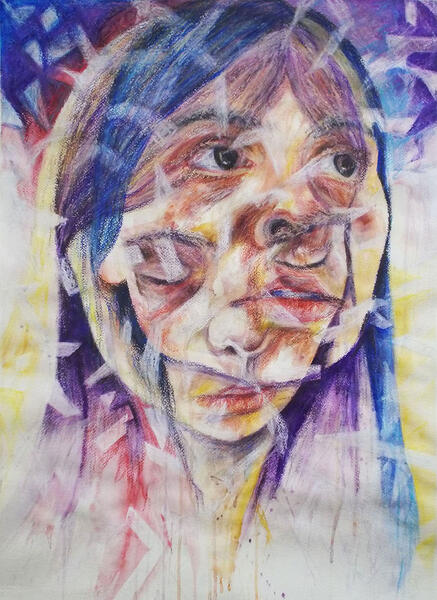 Lift My EyesA personal meditation on Psalm 121: 1-2: "I lift up my eyes to the hills--where does my help come from? My help comes from the Lord, the Maker of heaven and earth." In this double self-portrait, one face looks upward, while the other bows down in prayer, reflecting duality in a spiritual moment.
Lift My EyesA personal meditation on Psalm 121: 1-2: "I lift up my eyes to the hills--where does my help come from? My help comes from the Lord, the Maker of heaven and earth." In this double self-portrait, one face looks upward, while the other bows down in prayer, reflecting duality in a spiritual moment. -
 ResurrectionAn expression of the resurrection of my soul in Christ.
ResurrectionAn expression of the resurrection of my soul in Christ.
Biblical Names Portrait Series
I've started a new portrait series linking people with Biblical names to their historical counterparts, based on careful study.
-
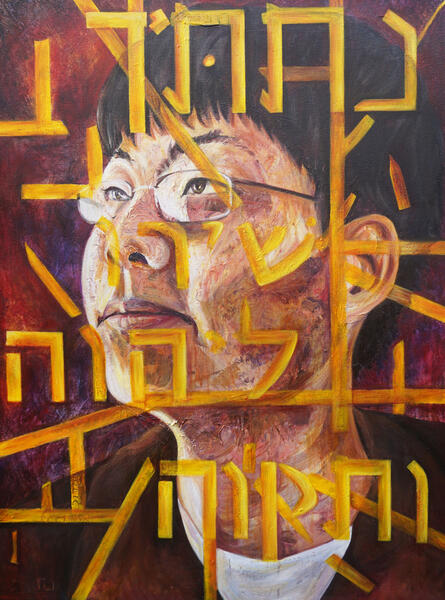 Jeremiah(n.), ירמיהו - "raised up by the LORD"The Hebrew text in the painting comes from various passages in the book of Jeremiah. From the top down: " I appointed you"(Jeremiah 1:5), "Sing to the LORD" (Jeremiah 20:13) and "and a hope"(Jeremiah 29:11). Jeremiah the prophet had a difficult task to speak God's Word to a people who didn't want to hear it. When God first called him, he did not feel adequate(Jeremiah 1:6). But God promised to be with him and rescue him (Jeremiah 1:8,19). He would make Jeremiah a "fortified city, an iron pillar and a bronze wall to stand against the whole land"(Jeremiah 1:18). Jeremiah foretold the destruction of Jerusalem and the captivity of Judah, which made him hated by the people. At times, he despaired because of the predicament he felt the LORD had given him (Jeremiah 20:7). But despite this, he knew the LORD was with him (Jeremiah 20:11), and he sang praise to Him(Jeremiah 20:13) even in hard times. This is a portrait of another Jeremiah, who was named after the man described above. Although separated by many millennia, the two share an enduring faith and hope in God, who is eternal. And like his namesake, this Jeremiah, who has been gifted with a beautiful voice, could join with his predecessor and say, "Sing to the LORD! Give praise to the LORD! He rescues the life of the needy from the hands of the wicked." (Jeremiah 20:13)
Jeremiah(n.), ירמיהו - "raised up by the LORD"The Hebrew text in the painting comes from various passages in the book of Jeremiah. From the top down: " I appointed you"(Jeremiah 1:5), "Sing to the LORD" (Jeremiah 20:13) and "and a hope"(Jeremiah 29:11). Jeremiah the prophet had a difficult task to speak God's Word to a people who didn't want to hear it. When God first called him, he did not feel adequate(Jeremiah 1:6). But God promised to be with him and rescue him (Jeremiah 1:8,19). He would make Jeremiah a "fortified city, an iron pillar and a bronze wall to stand against the whole land"(Jeremiah 1:18). Jeremiah foretold the destruction of Jerusalem and the captivity of Judah, which made him hated by the people. At times, he despaired because of the predicament he felt the LORD had given him (Jeremiah 20:7). But despite this, he knew the LORD was with him (Jeremiah 20:11), and he sang praise to Him(Jeremiah 20:13) even in hard times. This is a portrait of another Jeremiah, who was named after the man described above. Although separated by many millennia, the two share an enduring faith and hope in God, who is eternal. And like his namesake, this Jeremiah, who has been gifted with a beautiful voice, could join with his predecessor and say, "Sing to the LORD! Give praise to the LORD! He rescues the life of the needy from the hands of the wicked." (Jeremiah 20:13) -
 Rachel Ann (n.), רחל חנה - "beautiful grace"Rachel is my best friend, and a strong woman of faith. For her portrait, I took inspiration from her first and middle names: Rachel and Ann. In Hebrew, Rachel means "ewe," but for the purposes of our modern understanding, I've chosen the descriptor "beautiful" for the definition of her name, as this describes the Biblical Rachel (Genesis 29:17), wife and love of the patriarch Jacob and mother of Joseph and Benjamin. The English name Ann derives from the Hebrew name Hannah, meaning "grace". Hannah was the mother of the prophet and judge Samuel, and her story is detailed in 1 Samuel 1-2. These women lived centuries apart, but had a few commonalities to their stories. Both were barren, which was considered a disgrace in their time, although they dealt with their situations differently. While Rachel blamed her husband and took matters into her own hands instead of turning to God (Genesis 30:1-3), Hannah went to the house of the LORD and poured out her heart and soul to Him in prayer. In these cases, despite their differences, God extended His grace to both women and allowed them to conceive. Rachel bore Joseph, and Hannah, Samuel, both of whom became prominent figures in Israel's history. The phrase used in both Genesis 30:22 and 1 Samuel 1:19 is nearly the same in Hebrew, which translates to "and God remembered her," the words used in the top half of the painting. The latter two words come from Hannah's prayer of praise to the LORD when he answered her plea, and they read "I rejoice in your salvation" (1 Samuel 2:1). What connects these three women is not their personalities, but the "beautiful grace" of God at work in their lives. Today, God still works to take away disgrace--the disgrace of sin. In His love, He entered our existence as a human being, the spotless Lamb, lived perfectly and bore our sins and our disgrace on the cross, and rose again, triumphing over death and sin. Because of Christ, Rachel Ann can rejoice in His salvation and know that the Lord remembers her.
Rachel Ann (n.), רחל חנה - "beautiful grace"Rachel is my best friend, and a strong woman of faith. For her portrait, I took inspiration from her first and middle names: Rachel and Ann. In Hebrew, Rachel means "ewe," but for the purposes of our modern understanding, I've chosen the descriptor "beautiful" for the definition of her name, as this describes the Biblical Rachel (Genesis 29:17), wife and love of the patriarch Jacob and mother of Joseph and Benjamin. The English name Ann derives from the Hebrew name Hannah, meaning "grace". Hannah was the mother of the prophet and judge Samuel, and her story is detailed in 1 Samuel 1-2. These women lived centuries apart, but had a few commonalities to their stories. Both were barren, which was considered a disgrace in their time, although they dealt with their situations differently. While Rachel blamed her husband and took matters into her own hands instead of turning to God (Genesis 30:1-3), Hannah went to the house of the LORD and poured out her heart and soul to Him in prayer. In these cases, despite their differences, God extended His grace to both women and allowed them to conceive. Rachel bore Joseph, and Hannah, Samuel, both of whom became prominent figures in Israel's history. The phrase used in both Genesis 30:22 and 1 Samuel 1:19 is nearly the same in Hebrew, which translates to "and God remembered her," the words used in the top half of the painting. The latter two words come from Hannah's prayer of praise to the LORD when he answered her plea, and they read "I rejoice in your salvation" (1 Samuel 2:1). What connects these three women is not their personalities, but the "beautiful grace" of God at work in their lives. Today, God still works to take away disgrace--the disgrace of sin. In His love, He entered our existence as a human being, the spotless Lamb, lived perfectly and bore our sins and our disgrace on the cross, and rose again, triumphing over death and sin. Because of Christ, Rachel Ann can rejoice in His salvation and know that the Lord remembers her. -
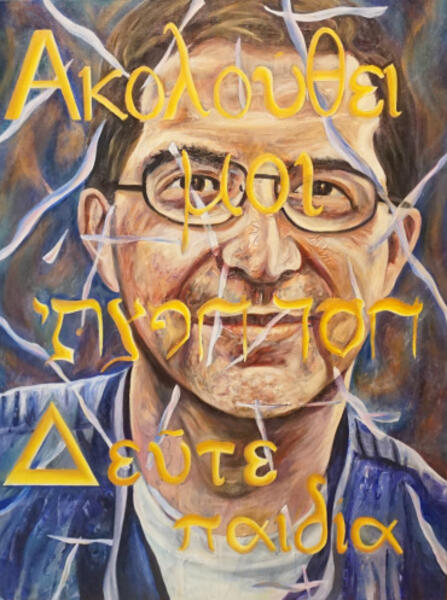 Matthew (n.), מתתיהו, Ματθαίος- gift of the LORD”“Matthew (n.), מתתיהו, Ματθαίος- gift of the LORD”, Acrylic on canvas, 30”x40”, 2019. Before encountering Jesus, Matthew, then called Levi, was a publican (or tax collector) for the Roman Empire, so he would have collected taxes on imports and goods from the people (often fellow Jews). Tax collectors were known to commit extortion, which was a violation of the Levitical Law, leading them to be hated by their own people and treated as “sinners” (a despised class). In Matthew 9:9, while Matthew is sitting at his tax collector’s booth, Jesus calls him to be His disciple, changing the trajectory of his life forever. The Greek and Hebrew text and shapes in the painting reflect important themes in Matthew’s Gospel. The first two Greek words are “Follow Me” (passage described above), which represent Jesus’ gracious call on Matthew’s life. The following Hebrew text, “I desire mercy” comes from Hosea 6:6. It is quoted twice by Matthew in Chapters 9 and 12 and emphasizes God’s value on active, sacrificial love rather than religious hypocrisy. The final Greek words, “Come little children,” combine Christ’s promise to give rest to the weary (Matthew 11:28-30) with his invitation to the little children to come (Matthew 19:14). The free-flowing, blue shapes further reflect on this spiritual rest offered in Jesus. My grandmother chose the name Matthew for my father (the painting’s subject) at God’s leading, before he was even born. He was a “gift of the LORD” to his family when he entered this world 8 days after his father’s tragic death. He answered Jesus’ call at age 6, embodying the childlike faith spoken of in his namesake’s Gospel. Like the Gospel author, he testifies about Jesus and His transforming love, and by God’s grace, his faithful witness has affected many lives, including my own.
Matthew (n.), מתתיהו, Ματθαίος- gift of the LORD”“Matthew (n.), מתתיהו, Ματθαίος- gift of the LORD”, Acrylic on canvas, 30”x40”, 2019. Before encountering Jesus, Matthew, then called Levi, was a publican (or tax collector) for the Roman Empire, so he would have collected taxes on imports and goods from the people (often fellow Jews). Tax collectors were known to commit extortion, which was a violation of the Levitical Law, leading them to be hated by their own people and treated as “sinners” (a despised class). In Matthew 9:9, while Matthew is sitting at his tax collector’s booth, Jesus calls him to be His disciple, changing the trajectory of his life forever. The Greek and Hebrew text and shapes in the painting reflect important themes in Matthew’s Gospel. The first two Greek words are “Follow Me” (passage described above), which represent Jesus’ gracious call on Matthew’s life. The following Hebrew text, “I desire mercy” comes from Hosea 6:6. It is quoted twice by Matthew in Chapters 9 and 12 and emphasizes God’s value on active, sacrificial love rather than religious hypocrisy. The final Greek words, “Come little children,” combine Christ’s promise to give rest to the weary (Matthew 11:28-30) with his invitation to the little children to come (Matthew 19:14). The free-flowing, blue shapes further reflect on this spiritual rest offered in Jesus. My grandmother chose the name Matthew for my father (the painting’s subject) at God’s leading, before he was even born. He was a “gift of the LORD” to his family when he entered this world 8 days after his father’s tragic death. He answered Jesus’ call at age 6, embodying the childlike faith spoken of in his namesake’s Gospel. Like the Gospel author, he testifies about Jesus and His transforming love, and by God’s grace, his faithful witness has affected many lives, including my own.









